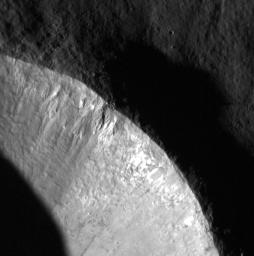Anatomy of a Fresh Crater
Caption:
Another look at the fresh impact crater seen
here
is revealed in this image. This time the image is showing incredible detail of erosional patterns on the crater wall and a glimpse of boulders just outside the crater rim.
This image was acquired as a high-resolution targeted observation. Targeted observations are images of a small area on Mercury's surface at resolutions much higher than the 200-meter/pixel morphology base map. It is not possible to cover all of Mercury's surface at this high resolution, but typically several areas of high scientific interest are imaged in this mode each week.
Date acquired:
March 02, 2015
Image Mission Elapsed Time (MET):
67659563
Image ID:
8076855
Instrument:
Narrow Angle Camera (NAC) of the Mercury Dual Imaging System (MDIS)
Center Latitude:
35.44°
Center Longitude:
207.64° E
Resolution:
5.33 meters/pixel
Scale:
This scene is approximately 2.7 km (1.7 miles) across
Incidence Angle:
78.43°
Emission Angle:
7.17°
Phase Angle:
85.60°
Background Info:
The MESSENGER spacecraft is the first ever to orbit the planet Mercury, and the spacecraft's
seven scientific instruments and radio science investigation
are unraveling the history and evolution of the Solar System's innermost planet. During the first two years of orbital operations, MESSENGER acquired over 150,000 images and extensive other data sets. MESSENGER is capable of continuing orbital operations until early 2015.
For information regarding the use of images, see the MESSENGER
image use policy
.
Cataloging Keywords:
| Name |
Value |
Additional Values |
| Target |
Mercury |
|
| System |
|
|
| Target Type |
Planet |
|
| Mission |
MESSENGER |
|
| Instrument Host |
MESSENGER |
|
| Host Type |
Orbiter |
|
| Instrument |
Mercury Dual Imaging System (MDIS) |
|
| Detector |
Narrow Angle Camera (NAC) |
|
| Extra Keywords |
Crater, Grayscale, Impact, Map, Radio |
| Acquisition Date |
|
| Release Date |
2015-03-27 |
| Date in Caption |
2015-03-02 |
|
| Image Credit |
NASA/Johns Hopkins University Applied Physics Laboratory/Carnegie Institution of Washington |
| Source |
photojournal.jpl.nasa.gov/catalog/PIA19261 |
| Identifier |
PIA19261 |

 Planetary Data System
Planetary Data System
